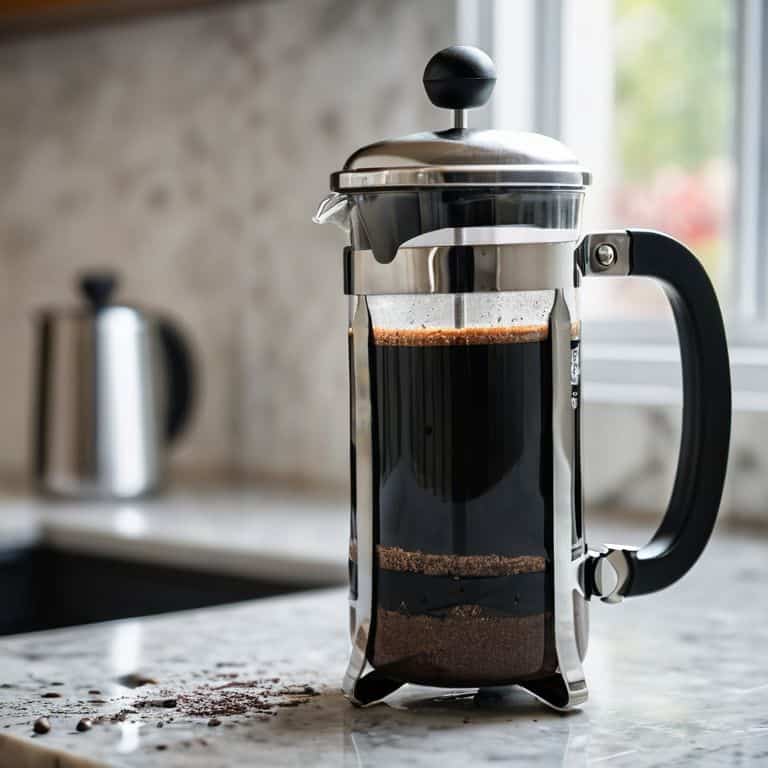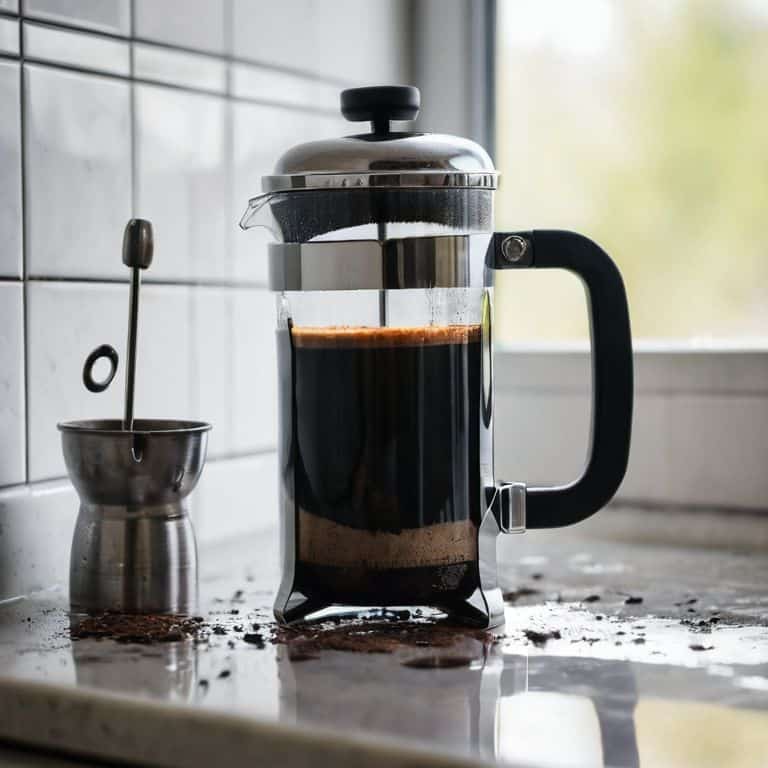I still remember the first time I tried to clean a French press – it was a disaster. The coffee oils had built up, and the whole thing was a sticky mess. I was determined to figure out how to clean a French press properly, and after months of trial and error, I finally cracked the code. It’s astonishing how many baristas and coffee enthusiasts still believe that cleaning a French press is a tedious, complicated process. The truth is, it’s quite simple once you understand the basics. I’ve spent years perfecting my technique, and now I’m excited to share my knowledge with you.
In this article, I’ll cut through the noise and give you the honest, no-hype advice you need to clean your French press like a pro. You’ll learn the exact steps to follow, from descaling to drying, and how to avoid common pitfalls that can leave your coffee tasting bitter or stale. By the end of this guide, you’ll be equipped with the knowledge to brew cafe-quality coffee at home, every time. Whether you’re a seasoned barista or a coffee newbie, I’ll show you that cleaning a French press is not only essential but also easy and rewarding. So, let’s dive in and explore the world of perfectly brewed coffee, starting with the foundation: a sparkling clean French press.
Table of Contents
Guide Overview: What You'll Need

Total Time: 30 minutes
Estimated Cost: $0 – $5
Difficulty Level: Easy
Tools Required
- Soft sponge (gentle on surfaces)
- Soft-bristled brush (for removing coffee grounds)
- Dish soap (mild and non-abrasive)
- Warm water (for rinsing)
- Towel (for drying)
Supplies & Materials
- Baking soda (optional for odor removal)
- White vinegar (optional for descaling)
Step-by-Step Instructions
- 1. First, start with a thorough rinse of your French press to remove any leftover coffee grounds and oils. I like to think of this step as a reset for my brewing device, getting it ready for a deep clean. Fill the French press with warm water, swirl it around, and then discard the water. This initial rinse helps loosen any stubborn particles that might be stuck to the glass or metal.
- 2. Next, mix 1 tablespoon of mild dish soap with 1 quart of warm water to create a soapy solution. I’m a fan of using a fragrance-free soap to avoid any residual scents that might affect the taste of my coffee. Dip a soft-bristled brush or a non-abrasive sponge into the soapy solution and gently scrub the interior and exterior of the French press, paying special attention to any areas with visible staining or buildup.
- 3. Now it’s time to tackle the plunger and filter components of your French press. Remove any removable parts and soak them in the soapy solution for about 10-15 minutes to help loosen any stubborn coffee oils and residue. After soaking, use the soft-bristled brush to scrub away any remaining particles and then rinse the parts thoroughly with warm water.
- 4. For a more in-depth cleaning, I recommend using a mixture of equal parts water and white vinegar to help break down any mineral deposits and coffee oils that might be affecting the taste of your brew. Fill the French press with this mixture, stir it well, and let it sit for about 30 minutes to an hour. The acid in the vinegar will help dissolve any stubborn residue and leave your French press smelling fresh and clean.
- 5. After the vinegar mixture has done its magic, discard the liquid and rinse the French press thoroughly with warm water to remove any lingering vinegar taste. To remove any water spots and give your French press a sparkling finish, dry it with a soft, lint-free cloth. This step is especially important if you’re using a glass French press, as water spots can leave unsightly mineral deposits on the surface.
- 6. To maintain the cleanliness and prevent any bacterial growth in your French press, I recommend cleaning it after every use and performing a deep clean like this one at least once a week. For a daily routine, simply rinse the French press with warm water after each use and wipe it dry with a soft cloth. This will help prevent any coffee oils from building up and making your French press more difficult to clean in the long run.
- 7. Finally, to put your French press back into service, reassemble any parts you removed during the cleaning process and rinse the entire device one last time with warm water. Now your French press is clean, fresh, and ready to brew a perfect cup of coffee. Remember to always use fresh, filtered water and the right coffee-to-water ratio to bring out the best flavors in your coffee. Happy brewing!
Cleaning a French Press Properly

As I delve deeper into the world of French press maintenance, I’ve come to realize that descaling a French press is just as crucial as cleaning it. You see, mineral buildup can affect the flavor of your coffee, and if you’re using a French press, you want to ensure that every sip is a perfect representation of the coffee’s true potential. I’ve found that using a mixture of water and vinegar to descale my French press every few months keeps it in top condition.
When it comes to removing old coffee residue, I’ve learned that gentle scrubbing is key. You don’t want to scratch the surface of your French press, but you do want to make sure that every last bit of residue is gone. I’ve developed a french press maintenance schedule that includes daily cleaning, weekly deep cleaning, and monthly descaling. It may seem like a lot, but trust me, it’s worth it.
For those who want to take their French press cleaning to the next level, I recommend experimenting with french press cleaning solutions. There are a variety of products on the market that can help remove old coffee oils and residue, leaving your French press tasting like new. And when you’re not using it, make sure to store your french press properly to prevent any buildup or damage. With a little practice and patience, you’ll be well on your way to brewing like a pro.
Descaling With Vinegar Solutions
To take your French press cleaning to the next level, I swear by descaling with vinegar solutions. It’s a game-changer for removing mineral deposits that can affect the taste of your coffee. I mix a solution of equal parts water and white vinegar, then soak the French press for about an hour. This helps break down any tough buildup.
After soaking, I rinse the French press thoroughly with fresh water to remove any lingering vinegar taste. It’s a simple yet effective method that keeps my French press in top condition. By descaling regularly, you’ll prevent any unwanted flavors from creeping into your brew, ensuring every cup tastes its best. Trust me, it’s worth the extra step – your coffee will thank you.
Removing Old Coffee Residue
To truly deep clean your French press, you need to tackle the old coffee residue that’s built up over time. I’m talking about the stubborn stains and oils that can affect the flavor of your brew. For this, I swear by a mixture of equal parts water and white vinegar. Simply fill your French press with the solution, stir, and let it sit for about an hour. The acid in the vinegar will break down the residue, making it easy to rinse away.
After the solution has done its magic, discard it and rinse your French press thoroughly with warm water. You can use a soft sponge or cloth to wipe away any remaining residue. I like to repeat this process a few times to ensure my French press is squeaky clean. Trust me, the extra effort is worth it – your coffee will taste noticeably cleaner and more vibrant.
Unlocking the Secrets of a Pristine French Press: 5 Expert Tips

- Measure your cleaning water to the exact gram to ensure the perfect balance of cleaning solution and water
- Use a thermometer to heat your cleaning water to precisely 93.5 degrees Celsius for optimal cleaning efficiency
- Select a cleaning vinegar with a 5% acidity level to effectively break down old coffee residues without damaging your French press
- Allocate exactly 7 minutes for the cleaning solution to sit and penetrate deep into the French press, allowing for a thorough descale
- Rinse your French press with filtered water that has been adjusted to a pH level of 7.2 to prevent any mineral deposits from forming during the cleaning process
Key Takeaways for a Sparkling French Press
Always descale your French press with a vinegar solution every 3-6 months to prevent mineral buildup and ensure a pure flavor profile
Regularly removing old coffee residue with a mixture of equal parts water and white vinegar will help maintain the optimal flavor and aroma of your brew
By following these simple steps and maintaining a clean French press, you’ll be well on your way to brewing cafe-quality coffee at home, every time, and unlocking the full potential of your coffee beans
The Cleaning Philosophy
A clean French press is not just a matter of hygiene, it’s a sensory rebirth – every residual note, every hidden stain, is a potential thief of flavor, waiting to hijack your next brew.
Julian Vale
The Perfect Brew: A Conclusion
As we’ve explored the world of French press cleaning, it’s clear that attention to detail is key. From descaling with vinegar solutions to removing old coffee residue, each step plays a crucial role in achieving that perfect cup. By following these steps and making them a part of your routine, you’ll be well on your way to brewing like a pro. Remember, cleaning your French press is not just about maintenance; it’s about respect for the craft and the beans. Every step, from measuring to pouring, is an act of devotion to the art of coffee making.
So, as you put these tips into practice and refine your skills, keep in mind that the pursuit of the perfect brew is a journey, not a destination. It’s about the joy of experimentation, the thrill of trying new roasts, and the satisfaction of sharing your creations with others. Whether you’re a seasoned barista or a humble home brewer, the world of coffee is full of endless possibilities, and with a clean French press and a keen sense of curiosity, you’ll be unlimited in your pursuit of coffee perfection.
Frequently Asked Questions
How often should I clean my French press to prevent old coffee oils from affecting the taste?
To keep your French press in top shape, I recommend cleaning it after every 3-4 uses. Old coffee oils can quickly go rancid, affecting the taste of your brew. A quick rinse with warm water and a mild soap can work wonders. For a deeper clean, descale with vinegar solution every 1-2 months to prevent mineral buildup. Trust me, your taste buds will thank you!
Can I use baking soda instead of vinegar for descaling my French press?
While baking soda can help remove old coffee residue, I wouldn’t recommend it for descaling your French press. Vinegar’s acidity is key to breaking down mineral deposits. Baking soda is more of a gentle scrubber, and it might not effectively remove limescale buildup. Stick with vinegar for descaling, and save the baking soda for removing old coffee oils and residue.
What's the best way to dry a French press after cleaning to prevent water spots and bacterial growth?
Drying is crucial, my friend. After rinsing, I use a microfiber cloth to wipe down the French press, paying extra attention to the lid and plunger. For the glass or ceramic body, a gentle shake and air dry is best. This prevents water spots and bacterial growth, ensuring your next brew is pure and untainted.



